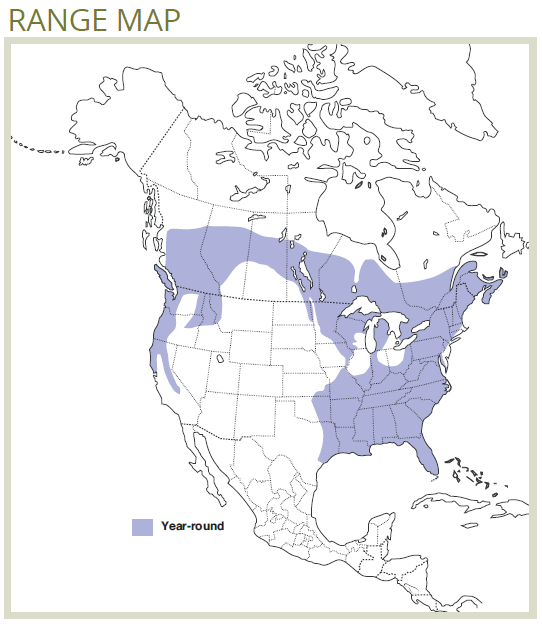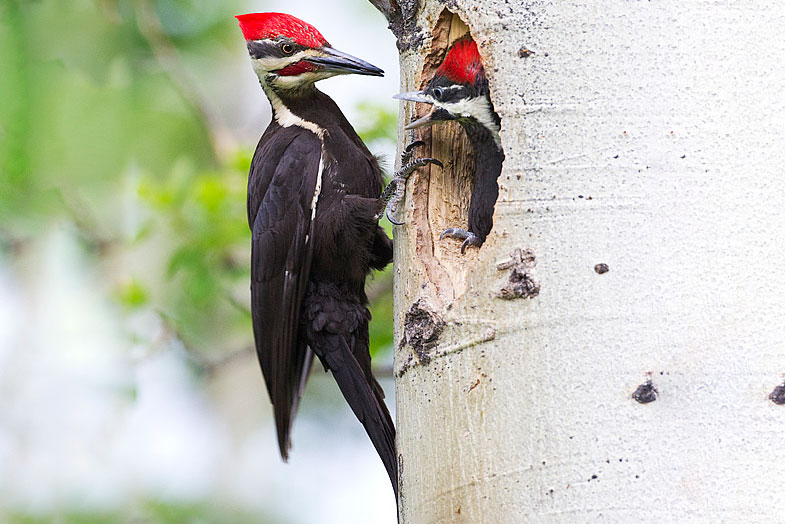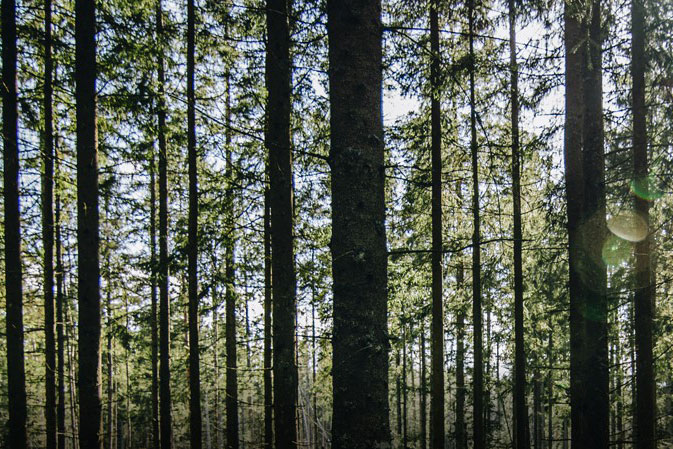One of the largest North American woodpeckers, the Pileated Woodpecker is easily spotted thanks to its bright red crest and loud call that resembles manic laughter. Many species reuse old Pileated Woodpecker cavity nests.
Pileated Woodpecker
(Dryocopus pileatus)
Habitat Ecology
- Pileated Woodpeckers are found in a wide range of forest types, including deciduous forests, mixedwoods, and dry mixed-conifer forests. Their occurrence is mainly driven by their need for large-diameter, decaying trees or snags which can be excavated for nests and roosts, and insect-infested deadwood for foraging.1
- In deciduous and mixed deciduous-coniferous forests, optimal nesting trees are >35 cm dbh, decay class 2 (live and unhealthy), and have 10–25 conks on average.2
- In dry mixed-conifer forests, optimal nesting trees include western larch, riparian black cottonwood, and ponderosa pine, although Douglas-fir is used to a smaller extent.3,4
- Due to their need for large, old trees for nesting and foraging, this species is mainly found in older forests, as well as forest stands containing snags and trees for foraging and nesting.5,6 Unlike some other woodpecker species, the Pileated Woodpecker is not associated with burned forests.7,8

Response to Forest Management
- The main impact of intensive harvesting is the removal of the large-diameter live and dead trees that Pileated Woodpeckers need for nesting, foraging, and roosting.1
- This species’ response to retention harvesting has been mixed.2,9 Regardless, they are rare or absent in clearcuts without residual trees up to at least 25 years postharvest,10 indicating that harvest strategies that include retention mitigate harvest effects at the very least and provide some foraging and nesting opportunities.11
Stand-level Recommendations
- Retention recommendations focus on identifying and protecting existing and potential cavity trees and other coarse woody debris for foraging. Retention anchor points include:
- Aspen trees with existing cavities should be used as retention anchor points, particularly if they are still alive or not heavily decayed as they will last longer.12 Additional aspen with the following characteristics should also be conserved in patches: >35 cm dbh, >25 m tall, with 10–25 false tinder conks and no live branches for 70% of the tree’s height.2,11
- Large-diameter western larch (77–91 cm dbh), ponderosa pine (76–96 cm dbh) within mixed ponderosa pine/Douglas fir groves, and black cottonwood (75–100 cm dbh) are recommended as retention patch anchor points where aspen is unavailable.4 Unlike aspen, broken-topped snags and trees/snags with existing cavities are a high priority, as these species and are more easily excavated when they have more decay.4
- Standing live and/or dead trees with visible carpenter ant colonization at the base (fine sawdust piles, woodpecker foraging holes, basal scars, etc.).6
- While heavily-decayed snags containing cavities may be too rotted for nesting, they may be suitable foraging habitat.13
Landscape-level Recommendations
- Traditional two-pass clear-cutting removes the old, large-diameter trees needed for nesting and produces even-aged stands where these important features are rare or absent. Harvest patterns more consistent with an area’s NRV are recommended. Particularly, harvest areas containing patches of older forest and suitable nest tree species are most likely to benefit this species.
- In aspen-dominated forests in the boreal mixedwood forest, for example, large aggregated harvests (1,000s of ha) with ~30% overall retention of mature and old aspen cover, and small aggregated harvests (100s of ha) with >30% retention in patches >10 ha) are recommended.14
- In dry coniferous forests, management areas of 300–400 ha are recommended within which ≥60% canopy closure is maintained within at least 50% of the management area.15
References
- Bull, E. L. and J. A. J. 2011. Pileated Woodpecker (Dryocopus pileatus), version 2.0. in The Birds of North America (Rodewald, P. G., ed.) Cornell Lab of Ornithology, Ithaca, New York, USA. Available online: https://doi.org/10.2173/bna.148
- Cooke, H. A. & Hannon, S. J. 2012. Nest-site selection by old boreal forest cavity excavators as a basis for structural retention guidelines in spatially-aggregated harvests. Forest Ecology and Management 269: 37–51. Available online: http://dx.doi.org/10.1016/j.foreco.2011.12.042
- Hutto, R. L. & Young, J. S. 1999. Habitat relationships of landbirds in the Northern Region, USDA Forest Service. Gen. Tech. Rep. RMRS-GTR-32. U.S. Department of Agriculture, Forest Service, Rocky Mountain Research Station, Ogden, UT. 72 pp. Available online: https://www.fs.fed.us/rm/pubs/rmrs_gtr032.pdf
- McClelland, B. R. & McClelland, P. T. 1999. Pileated woodpecker nest and roost trees in Montana: links with old-growth and forest ‘health’. Wildlife Society Bulletin 27: 846–857. Available online: http://www.jstor.org/stable/3784108
- ABMI. 2017. Pileated Woodpecker (Dryocopus pileatus). ABMI Species Website, version 4.1 Available online: http://species.abmi.ca/pages/species/birds/PileatedWoodpecker.html
- Bonar, R. 2018. Personal communication. April 6, 2018
- Koivula, M. J. & Schmiegelow, F. K. A. 2007. Boreal woodpecker assemblages in recently burned forested landscapes in Alberta, Canada: Effects of post-fire harvesting and burn severity. Forest Ecology and Management 242: 606–618. Available online: https://doi.org/10.1016/j.foreco.2007.01.075
- Schieck, J. & Song, S. J. 2006. Changes in bird communities throughout succession following fire and harvest in boreal forests of western North America: literature review and meta-analyses. Canadian Journal of Forest Research 36: 1299–1318. Available online: https://doi.org/10.1139/x06-017
- Drever, M. C. & Martin, K. 2010. Response of woodpeckers to changes in forest health and harvest: Implications for conservation of avian biodiversity. Forest Ecology and Management 259: 958–966.
- Hobson, K. A. & Bayne, E. M. 2000. The effects of stand age on avian communities in aspen- dominated forests of central Saskatchewan, Canada. Forest Ecology and Management 136: 121–134. Available online: https://doi.org/10.1016/S0378-1127(99)00287-X
- Bonar, R. L. 2001. Pileated Woodpecker Habitat Ecology in the Alberta Foothills. Ph.D. Thesis. Dept. Renewable Resources, University of Alberta, Edmonton, AB. 75 pp.
- Edworthy, A. B. & Martin, K. 2014. Long-term dynamics of the characteristics of tree cavities used for nesting by vertebrates. Forest Ecology and Management 334: 122–128. Available online: http://dx.doi.org/10.1016/j.foreco.2014.09.001
- Blanc, L. A. & Martin, K. 2012. Identifying suitable woodpecker nest trees using decay selection profiles in trembling aspen (Populus tremuloides). Forest Ecology and Management 286: 192–202.
- Cooke, H. A. & Hannon, S. J. 2011. Do aggregated harvests with structural retention conserve the cavity web of old upland forest in the boreal plains? Forest Ecology and Management 261: 662–674. Available online: http://dx.doi.org/10.1016/j.foreco.2010.11.023
- Bull, E. L. & Holthausen, R. S. 1993. Habitat use and management of pileated woodpeckers in northeastern Oregon. The Journal of Wildlife Management 57: 335–345. Available online: http://www.jstor.org/stable/3809431








